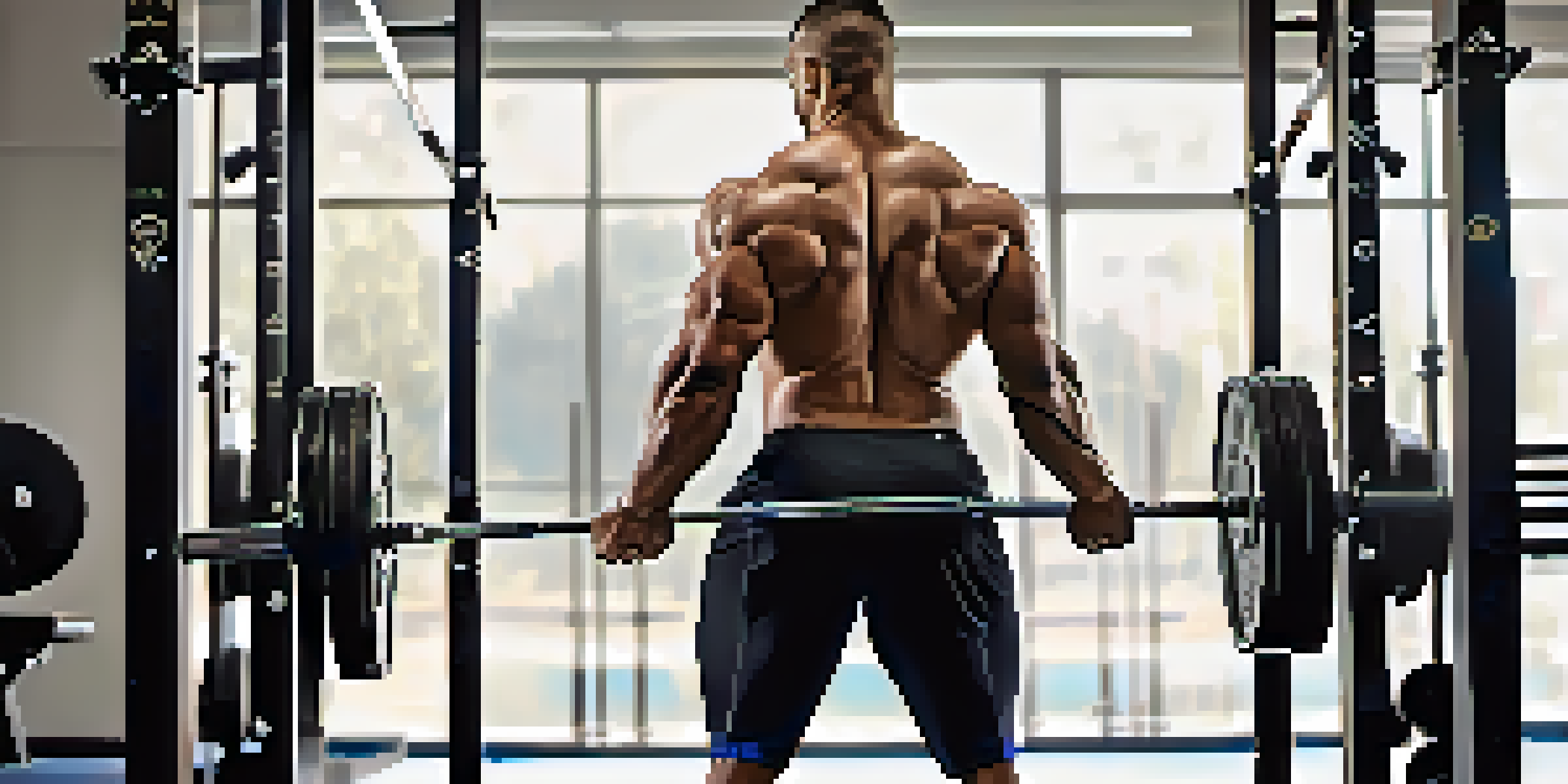The Role of Powerlifting in Strengthening Injured Muscles

Understanding Powerlifting and Its Benefits
Powerlifting is a strength sport that focuses on three main lifts: the squat, bench press, and deadlift. These lifts are not just about lifting heavy weights; they also promote functional strength, which can be incredibly beneficial for overall health. Through structured training, powerlifting helps improve muscle coordination and stability, essential factors for anyone recovering from an injury.
Strength does not come from physical capacity. It comes from an indomitable will.
One of the most significant benefits of powerlifting is its emphasis on proper form and technique. This focus helps prevent further injuries, making it a safe option for those looking to rehabilitate. By adhering to a well-structured training program, individuals can gradually increase their strength without overloading their recovering muscles.
Furthermore, powerlifting encourages mental resilience. The discipline required to lift heavier weights translates to a mental toughness that can aid in the rehabilitation process. This psychological aspect is often overlooked but plays a crucial role in how effectively someone can recover from an injury.
The Science Behind Muscle Recovery Through Powerlifting
Injury often leads to muscle atrophy, where muscles weaken and shrink due to disuse. Powerlifting can counteract this through progressive overload, a principle where the weight is gradually increased to stimulate muscle growth. This method ensures that injured muscles are reconditioned properly without overwhelming them.

Additionally, powerlifting promotes blood circulation, which is vital for healing. Improved blood flow delivers essential nutrients and oxygen to the injured area, accelerating recovery. Think of it as watering a plant; the more you nourish it, the healthier it becomes.
Powerlifting Boosts Recovery
Powerlifting's structured training enhances muscle coordination and stability, making it beneficial for rehabilitation.
Moreover, strength training has been shown to enhance collagen synthesis, which is crucial for repairing connective tissues. As powerlifting encourages muscle engagement, it indirectly supports the healing of ligaments and tendons, making it a multifaceted approach to recovery.
Incorporating Powerlifting Post-Injury: A Step-by-Step Guide
Starting powerlifting after an injury should always be approached cautiously. It's essential to consult with a healthcare professional or physical therapist to assess readiness. They can help create a tailored program that aligns with your recovery goals.
The difference between a successful person and others is not a lack of strength, not a lack of knowledge, but rather a lack in will.
Begin with lighter weights, focusing on form and technique rather than the amount lifted. This gradual reintroduction helps build confidence and ensures that the injured muscles are not strained. Think of it like learning to ride a bike again; you wouldn't jump straight to racing.
As you progress, slowly increase weights while monitoring your body's response. Keeping a journal of your workouts can be helpful to track improvements and identify any discomfort. This methodical approach ensures that you’re strengthening your muscles without risking re-injury.
The Importance of Warm-Up and Cool Down in Powerlifting
Warm-ups are crucial for anyone engaging in strength training, particularly for those recovering from injuries. A proper warm-up increases blood flow and prepares your muscles for the upcoming workload. This practice is especially important in powerlifting, where the movements are intense and require significant muscle engagement.
Incorporating dynamic stretches and lighter sets can serve as an effective warm-up routine. These activities not only prepare your body but also help in mentally gearing up for the lifts ahead. Think of it as tuning an instrument before a performance; a good warm-up sets the stage for success.
Listen to Your Body's Signals
Recognizing signs of overtraining is crucial for safely progressing in powerlifting, especially after an injury.
Equally important is the cool-down phase, which should not be overlooked. Engaging in static stretches post-workout can help alleviate muscle soreness and improve flexibility. This phase allows your body to transition back to a resting state, reducing the risk of injury and promoting overall recovery.
Listening to Your Body: Recognizing Signs of Overtraining
One of the most critical aspects of powerlifting, especially post-injury, is learning to listen to your body. While pushing through barriers is a part of strength training, it’s vital to recognize when your body signals distress. Signs of overtraining can include persistent fatigue, decreased performance, and increased soreness.
If you notice these symptoms, it may be time to reassess your training routine. Taking a step back and allowing adequate rest is essential for healing, both physically and mentally. Remember, recovery is just as important as the training itself.
Incorporating rest days and ensuring you have a balanced workout plan can help prevent overtraining. It’s not just about lifting heavier; it’s about smart training that fosters long-term growth and health.
Nutritional Considerations for Strengthening Injured Muscles
Nutrition plays a pivotal role in muscle recovery and overall performance in powerlifting. A balanced diet rich in protein, healthy fats, and carbohydrates provides the necessary fuel for your workouts and recovery. Proteins, in particular, are crucial for repairing muscle tissue, making them a vital component of your post-injury diet.
Incorporating anti-inflammatory foods can also assist in recovery. Foods like berries, fatty fish, and leafy greens can help reduce inflammation, promoting quicker healing. Think of your diet as the oil that keeps the engine running smoothly.
Nutrition Aids Muscle Healing
A balanced diet rich in protein and anti-inflammatory foods supports muscle recovery and overall performance in powerlifting.
Staying hydrated is equally important. Water helps transport nutrients throughout the body and aids in muscle recovery. Aim for consistent hydration throughout the day, not just during workouts, to ensure your body functions optimally.
Seeking Professional Guidance: Coaches and Therapists
Engaging with a qualified coach or therapist can significantly enhance your powerlifting experience, especially during recovery. They can provide personalized guidance, ensuring that your techniques are correct and your training is appropriate for your injury status. This professional oversight can prevent setbacks and help you progress safely.
A knowledgeable coach can also introduce variations in your training to accommodate your recovery needs. They can help design a program that includes alternative exercises that still engage the muscles without risking injury.

Additionally, therapists can assist in addressing specific concerns related to your injury. They can provide targeted exercises and recovery techniques that complement your powerlifting routine, creating a holistic approach to your rehabilitation.